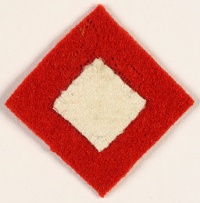The 10th Armoured Brigade was a short-lived armoured brigade of the British Army in the Second World War. It had been converted in November 1941 from 125th Infantry Brigade, but had never seen action and was disbanded in late 1943.
The 18th Infantry Brigade was an infantry brigade of the British Army that saw active service during the First and the Second World Wars.

The 42nd Armoured Division was an armoured division of the British Army raised during the Second World War.

The Sherwood Foresters was a line infantry regiment of the British Army in existence for just under 90 years, from 1881 to 1970. In 1970, the regiment was amalgamated with the Worcestershire Regiment to form the Worcestershire and Sherwood Foresters Regiment, which in 2007 was amalgamated with the Cheshire Regiment and the Staffordshire Regiment to form the present Mercian Regiment. The lineage of the Sherwood Foresters is now continued by The Mercian Regiment.
Colonel Claude Granville Lancaster was a British Army officer, coal industry director, and Conservative Party politician.

The King's Own Royal Regiment (Lancaster) was a line infantry regiment of the British Army. It served under various titles and fought in many wars and conflicts, including both the First and the Second World Wars, from 1680 to 1959. In 1959, the regiment was amalgamated with the Border Regiment to form the King's Own Royal Border Regiment.

The Border Regiment was a line infantry regiment of the British Army, which was formed in 1881 under the Childers Reforms by the amalgamation of the 34th (Cumberland) Regiment of Foot and the 55th (Westmorland) Regiment of Foot.

The 126th Brigade was an infantry brigade of the British Army during the First World War and the Second World War. It was assigned to the 42nd Division and served in the Middle East and on the Western Front in the Great War. In the Second World War, now as the 126th Infantry Brigade, it served again with the 42nd Division in France and was evacuated at Dunkirk and then later converted into 11th Armoured Brigade.

The 144th Regiment Royal Armoured Corps was an armoured regiment of the British Army. Originally raised during World War II as a battalion of the East Lancashire Regiment it was later transferred to the Royal Armoured Corps. It fought in the campaign in North-West Europe, from June 1944 to May 1945.

The 148th Regiment Royal Armoured Corps was an armoured regiment of the British Army's Royal Armoured Corps during World War II. It fought in the invasion of Normandy in 1944.
The 107th Regiment Royal Armoured Corps (King's Own) (107 RAC) was a tank regiment of the Royal Armoured Corps, raised by the British Army during the Second World War. The regiment served with distinction in North-west Europe from July 1944 to May 1945.
The 151st Regiment Royal Armoured Corps was an armoured regiment of the British Army's Royal Armoured Corps that was raised during the Second World War.
The 153rd Regiment Royal Armoured Corps was an armoured regiment of the Royal Armoured Corps, part of the British Army, and was raised during the Second World War. The regiment saw brief but intense action in the invasion of Normandy before being broken up to provide replacements to other units.
108 Regiment Royal Armoured Corps (The Lancashire Fusiliers) (108 RAC) was an armoured regiment of the British Army's Royal Armoured Corps during World War II.
109th Regiment Royal Armoured Corps (The Lancashire Fusiliers) (109 RAC) was an armoured regiment of the British Army's Royal Armoured Corps during World War II.
The 143rd Regiment Royal Armoured Corps was a short-lived armoured regiment of the British Army's Royal Armoured Corps during World War II.
The 110th Regiment Royal Armoured Corps (Border Regiment) (110 RAC) was an armoured regiment of the British Army's Royal Armoured Corps raised during the Second World War.
The 111th Regiment Royal Armoured Corps (Manchester Regiment) (111 RAC) was an armoured regiment of the British Army, raised by the Royal Armoured Corps during the Second World War.






